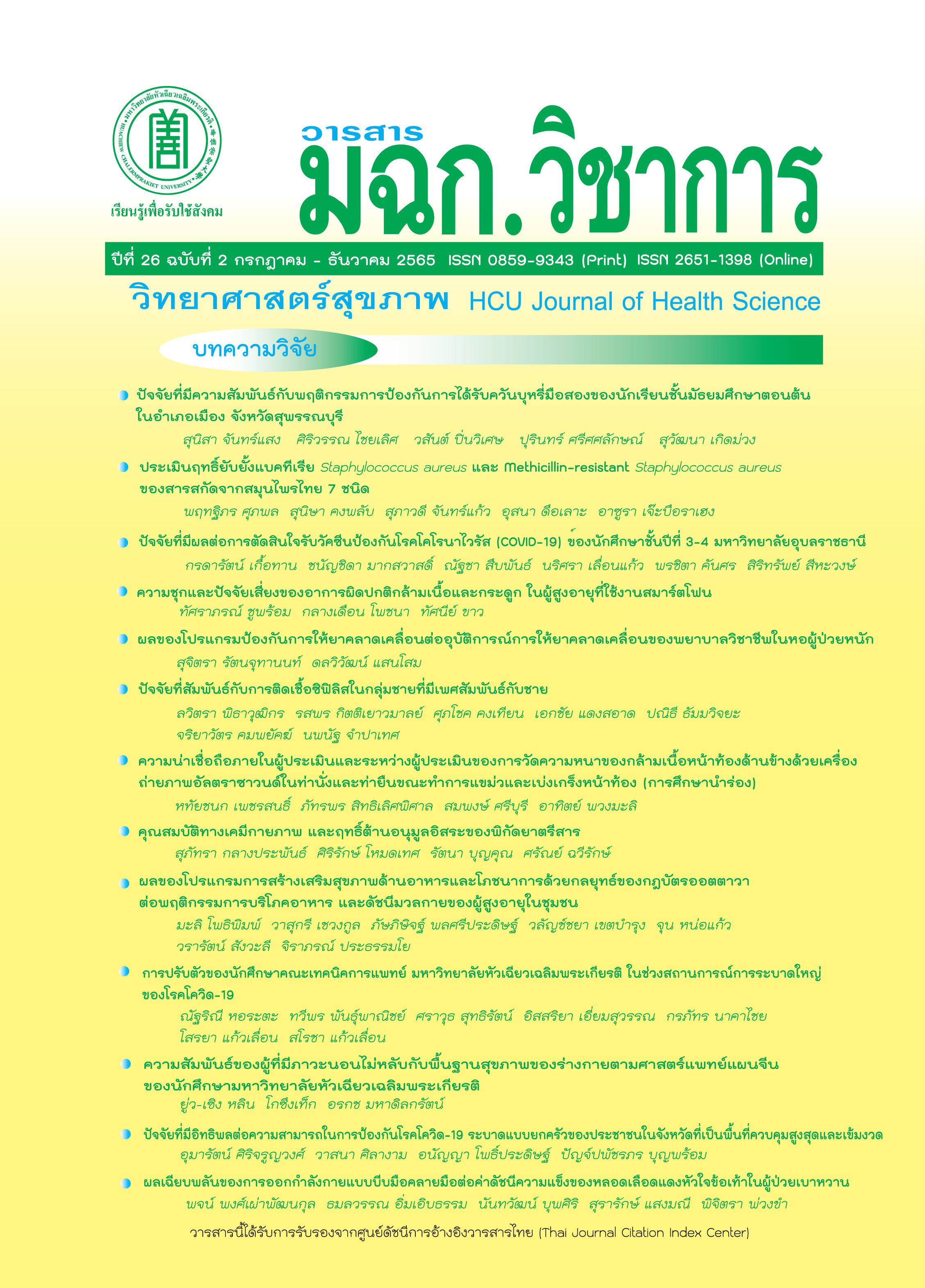Factors Affecting the Ability to Prevent COVID-19 spread within the whole family of People within Provinces which Controlled the Highest and Strictest Pandemic
Keywords:
Prevention of infectious diseases, Spread of COVID-19 in the whole familyAbstract
The objective of this study was to study the factors influencing the home sanitation ability to prevent the spread of 2019 coronavirus in people’s home in the highest and strictest controlled provinces. The sample was the population that is located in 5 provinces, namely Saraburi Samutprakan, Chonburi, Prachinburi and Songkhla, with a total of 579 people. The research tool was a questionnaire consisting of 5 parts: personal and family characteristics, the physical characteristics of the home or residence, the health literacy and the home sanitation ability to prevent the spread of 2019 coronavirus in home by a housekeeper and the preventive behaviors of respiratory infections of those who work outside the home every day. The questionnaire was of content validity with the item-objective congruence (IOC) of 0.67-1.00 and Cronbach's alpha coefficient of 0.72-0.95. The study was conducted in September 2021-February 2022. Data were analyzed using Pearson correlation and stepwise multiple regression.
The results indicated that the conducive conditions of the physical characteristics of the home or residence for the prevention of infection with 2019 coronavirus in the home were at a high level (Mean = 7.10, SD = 1.46). The sample group had a high level of evaluation in the health knowledge at a high level, the ability to keep the home safe from 2019 coronavirus infection within the family and prevention behaviors for respiratory infections of family members who go out to work. (Means = 4.25, 4.25 and 4.44 respectively). However, there are two factors namely the preventive behaviors of respiratory infections of those who go out to work (X1) and the ability to keep the home safe from 2019 coronavirus infection within the family (X2), which can predict together the home sanitation ability to prevent the spread of 2019 coronavirus equal a percentage of 65.90. The equation predicting the home sanitation ability to prevent the spread of 2019 coronavirus in people’s home = -0.222+ 0.0.509X1+0.520X2
Downloads
References
กระทรวงสาธารณสุข. สถานการณ์ผู้ติดเชื้อ COVID-19 [อินเทอร์เน็ต]. 2564. [เข้าถึงเมื่อ 25 ตุลาคม2564]. เข้าถึงได้จาก: https://ddc.moph.go.th/covid19-dashboard/?dashboard=main
กลุ่มพัฒนาวิชาการโรคติดต่อ กรมควบคุมโรค. มาตรการการป้องกันการแพร่ระบาดของเชื้อไวรัสโคโรนาสายพันธุ์ใหม่2019ระลอก 3 [อินเทอร์เน็ต]. 2564 [เข้าถึงเมื่อ 24 พฤศจิกายน 2564]. เข้าถึงได้จาก: https://chat.line.biz/U01b55ac01d99b0c04c25e65274a1cc23/chat/U796e1d50fda9baedb6ef8b7a8feea81e.
Lai ZFY, Kaur S. Home hygiene and prevention of infection in the home. Asia Pacific J. of Health Management 2020; 15(2):1-6.
สำนักอนามัยสิ่งแวดล้อม. คู่มือ โครงการบ้านสะอาด อนามัยดี ชีวีสมบูรณ์. พิมพ์ครั้งที่ 1. กรุงเทพฯ: โรงพิมพ์องค์การรับส่งสินค้าและพัสดุภัณฑ์ (ร.ส.พ.); 2556.
กรมควบคุมโรค. โรคติดเชื้อไวรัสโคโรนาสายพันธุ์ใหม่2019. [อินเทอร์เน็ต]. 2564 [เข้าถึงเมื่อ 24 พฤศจิกายน 2564]. เข้าถึงได้จาก: https://ddc.moph.go.th/viralpneumonia/.
Uraikukul C Thai Health Literacy Promotion Association. Review health literacy healthcare setting. [internet]. 2020 [ cited 2021 Feb 19] Available from: THLA.http://doh.hpc.go.th/bs/displayArticle.php?id=.
Creative Research Systems. Sample size calculator. [internet]. 2020 [cited 2021 Feb 19]. Available from: https://www.surveysystem.com/sscalc.htm
ชนวนทอง ธนสุกาญจน์, วิมล โรมา, มุกดา สำนวนกลาง. แนวคิดหลักการขององค์กรรอบรู้ด้านสุขภาพ. พิมพ์ครั้งที่ 1. กรุงเทพฯ: สำนักงานโครงการขับเคลื่อนกรมอนามัย 4.0 เพื่อความรอบรู้ด้านสุขภาพของประชาชน (สขรส.); 2561.
กรมควบคุมโรค. แนวทางปฏิบัติเพื่อการป้องกันโรคติดเชื้อไวรัสโคโรนา 2019 (COVID-19) หรือโควิด 19 สำหรับประชาชนทั่วไปและกลุ่มเสี่ยง [อินเทอร์เน็ต]. 2564 [เข้าถึงเมื่อ 10 กันยายน 2564]. เข้าถึงได้จาก: https://ddc.moph.go.th/viralpneumonia/file/int_protection/int_protection_030164.-pdf.
กรมอนามัย กระทรวงสาธารณสุข. แนวทางปฏิบัติสำหรับประชาชนในการจัดการดูแลที่พักอาศัยในสถานการณ์การระบาดของโรคติดเชื้อไวรัสโคโรนา 2019 (COVID-19) [อินเทอร์เน็ต]. 2563 [เข้าถึงเมื่อ 29 ธันวาคม 2563]. เข้าถึงได้จาก: https://covid19.anamai.moph.go.th/th/general-public/
ธวัชชัย เนียรวิฑรย์. การสุขาภิบาลสิ่งแวดล้อม: การสุขาภิบาลที่พักอาศัย. ขอนแก่น: ภาควิชาวิทยาศาสตร์สุขาภิบาล คณะสาธารณสุขศาสตร์มหาวิทยาลัยขอนแก่น; 2560.
Best JW. Research in education. 3rd ed. Englewood Cliffs, New Jersey: Prentice. Hall Inc; 1981.
Environmental Protection Agency. Indoor air in homes and coronavirus (COVID-19) [internet]. 2021 [cited 2020 Sep 10]. Available from: https://www.epa.gov/coronavirus/ -indoor air-homes-and-coronavirus-covid-19
Shahmir HA, Tim F, Lansbury N, Hall N. The relationship between infectious diseases and housing maintenance in indigenous Australian households. Int J Environ Res Public Health 2018;15(12):2827.
Roy CJ, Milton DK. Airborne transmission of communicable infection the elusive pathway. N Engl J Med 2004;350(17):1710-2.
Brownson RC, Petift DB. Applied epidemiology: Theory to practice 2nd. New York: Oxford University; 2006.
หนึ่งฤทัย ศรีสง, ธนวดี จันทร์เทียน, ณัฐปราง นิตยสุทธิ์, ระพีพงศ์ สุพรรณไชยมาตย์. การวิเคราะห์เชิงพรรณนาสถานการณ์การระบาดโรคติดเชื้อไวรัสโคโรนา 2019 ในสถานบันเทิงของไทย. ว.วิชาการสาธารณสุข 2564;30 (ฉบับเพิ่มเติม): S5-S13.
Nutbeam D. Health literacy as a public health goal: A challenge for contemporary health education and communication strategies into health 21st century. J. Health Literacy as a Public Goal, 15(8); 259-67.
Downloads
Published
How to Cite
Issue
Section
License
Copyright (c) 2022 HCU Journal

This work is licensed under a Creative Commons Attribution-NonCommercial-NoDerivatives 4.0 International License.
บทความที่ได้รับการตีพิมพ์เป็นลิขสิทธิ์ของวารสารวิทยาศาสตร์สุขภาพและสุขภาวะ
ข้อความที่ปรากฏในบทความแต่ละเรื่องในวารสารวิชาการเล่มนี้เป็นความคิดเห็นส่วนตัวของผู้เขียนแต่ละท่านไม่เกี่ยวข้องกับมหาวิทยาลัยหัวเฉียวเฉลิมพระเกียรติ และคณาจารย์ท่านอื่นๆในมหาวิทยาลัยฯ แต่อย่างใด ความรับผิดชอบองค์ประกอบทั้งหมดของบทความแต่ละเรื่องเป็นของผู้เขียนแต่ละท่าน หากมีความผิดพลาดใดๆ ผู้เขียนแต่ละท่านจะรับผิดชอบบทความของตนเองแต่ผู้เดียว




